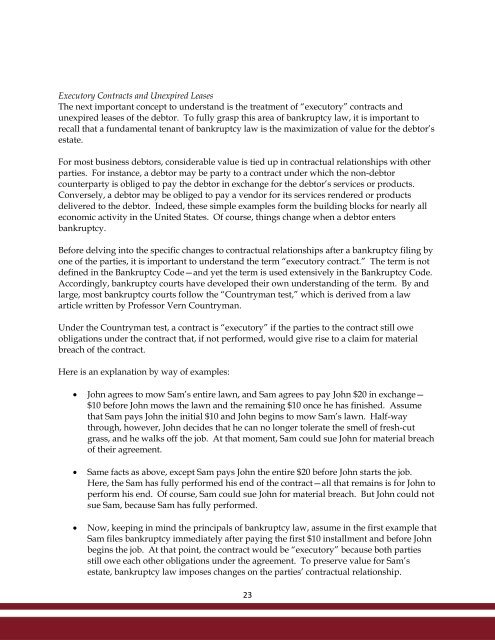Guide-for-Nonprofit-Organizations-Bankruptcy-Issues-FINAL-with-ads
Guide-for-Nonprofit-Organizations-Bankruptcy-Issues-FINAL-with-ads
Guide-for-Nonprofit-Organizations-Bankruptcy-Issues-FINAL-with-ads
- No tags were found...
Create successful ePaper yourself
Turn your PDF publications into a flip-book with our unique Google optimized e-Paper software.
Executory Contracts and Unexpired LeasesThe next important concept to understand is the treatment of ―executory‖ contracts andunexpired leases of the debtor. To fully grasp this area of bankruptcy law, it is important torecall that a fundamental tenant of bankruptcy law is the maximization of value <strong>for</strong> the debtor’sestate.For most business debtors, considerable value is tied up in contractual relationships <strong>with</strong> otherparties. For instance, a debtor may be party to a contract under which the non-debtorcounterparty is obliged to pay the debtor in exchange <strong>for</strong> the debtor’s services or products.Conversely, a debtor may be obliged to pay a vendor <strong>for</strong> its services rendered or productsdelivered to the debtor. Indeed, these simple examples <strong>for</strong>m the building blocks <strong>for</strong> nearly alleconomic activity in the United States. Of course, things change when a debtor entersbankruptcy.Be<strong>for</strong>e delving into the specific changes to contractual relationships after a bankruptcy filing byone of the parties, it is important to understand the term ―executory contract.‖ The term is notdefined in the <strong>Bankruptcy</strong> Code—and yet the term is used extensively in the <strong>Bankruptcy</strong> Code.Accordingly, bankruptcy courts have developed their own understanding of the term. By andlarge, most bankruptcy courts follow the ―Countryman test,‖ which is derived from a lawarticle written by Professor Vern Countryman.Under the Countryman test, a contract is ―executory‖ if the parties to the contract still oweobligations under the contract that, if not per<strong>for</strong>med, would give rise to a claim <strong>for</strong> materialbreach of the contract.Here is an explanation by way of examples:John agrees to mow Sam’s entire lawn, and Sam agrees to pay John $20 in exchange—$10 be<strong>for</strong>e John mows the lawn and the remaining $10 once he has finished. Assumethat Sam pays John the initial $10 and John begins to mow Sam’s lawn. Half-waythrough, however, John decides that he can no longer tolerate the smell of fresh-cutgrass, and he walks off the job. At that moment, Sam could sue John <strong>for</strong> material breachof their agreement.Same facts as above, except Sam pays John the entire $20 be<strong>for</strong>e John starts the job.Here, the Sam has fully per<strong>for</strong>med his end of the contract—all that remains is <strong>for</strong> John toper<strong>for</strong>m his end. Of course, Sam could sue John <strong>for</strong> material breach. But John could notsue Sam, because Sam has fully per<strong>for</strong>med.Now, keeping in mind the principals of bankruptcy law, assume in the first example thatSam files bankruptcy immediately after paying the first $10 installment and be<strong>for</strong>e Johnbegins the job. At that point, the contract would be ―executory‖ because both partiesstill owe each other obligations under the agreement. To preserve value <strong>for</strong> Sam’sestate, bankruptcy law imposes changes on the parties’ contractual relationship.23


